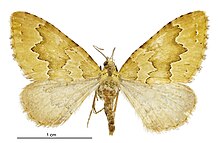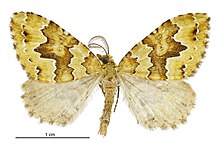Asaphodes philpotti
| Asaphodes philpotti | |
|---|---|

| |
| Female | |

| |
| Male | |
| Scientific classification | |
| Domain: | Eukaryota |
| Kingdom: | Animalia |
| Phylum: | Arthropoda |
| Class: | Insecta |
| Order: | Lepidoptera |
| Family: | Geometridae |
| Genus: | Asaphodes |
| Species: | A. philpotti
|
| Binomial name | |
| Asaphodes philpotti | |
| Synonyms[2] | |
| |
Asaphodes philpotti, also known as the bright green carpet moth,[3] is a moth in the family Geometridae.[2] It is endemic to New Zealand and has been found from the central North Island as well as in the South Island. This species inhabits wet native forest and larvae are hosted by species in the genera Hydrocotyle and Cardamine.
Taxonomy
[edit]This species was first described by Louis Beethoven Prout in 1927 and named Xanthorhoe philpotti.[4] Prout named this species in honour of Alfred Philpott, the entomologist who recognised that two separate species were mixed as Xanthorhoe beata.[4] In 1939 Prout placed this species in the genus Larentia.[5] This placement was not accepted by New Zealand taxonomists.[6] In 1988 J. S. Dugdale placed this species in the genus Asaphodes.[2] The male lectotype, collected at Lake Wakatipu, is held at the Natural History Museum, London.[2]
Description
[edit]
Prout stated that one of the distinguishing features between A. beata and A. philpotti is the black discal spot on the forewings of A. beata which is absent or very faintly present on the forewings of A. philpotti.[4]
Distribution
[edit]This species is endemic to New Zealand and can be found from the central North Island and the South Island.[1][3] This species has been collected at the type locality of Lake Wakatipu as well as in Dunedin, Wairaurahiri River in Southland, and Wainuiomata.[7][8][9] It has also been observed on the West Coast as well as in Takaka.[10] The range of this species has undergone contraction and it is now regarded as locally extinct in Invercargill.[11]
Habitat and hosts
[edit]
The preferred habitat of this species is native forest preferably with high rainfall.[11] Larvae from this species have been reared on, and have also been observed feeding on, species in the genera Hydrocotyle and Cardamine.[12]
Behaviour
[edit]Adults are on the wing from January to March.[3]
References
[edit]- ^ a b "Asaphodes philpotti (Prout, 1927))". www.nzor.org.nz. Retrieved 2022-01-22.
- ^ a b c d Dugdale , J. S. (23 September 1988). "Lepidoptera - annotated catalogue, and keys to family-group taxa". Fauna of New Zealand. 14. Department of Scientific and Industrial Research: 174. doi:10.7931/J2/FNZ.14. ISSN 0111-5383. Wikidata Q45083134.
- ^ a b c Crowe, Andrew (2017). Which New Zealand insect?. Penguin Books. p. 21. ISBN 978-0-14-100636-9.
- ^ a b c Louis Beethoven Prout (15 August 1927). "Notes on New Zealand Geometridae". Transactions and Proceedings of the New Zealand Institute. 58: 77–78. ISSN 1176-6158. Wikidata Q110670763.
- ^ Prout, L. B. (1939). "Geometridae: Fauna Indo-Australica". The Macrolepidoptera of the World. 12: 264 – via Biodiversity Heritage Library.
- ^ R. C. Craw (April 1987). "Revision of the genus Helastia sensu stricto with description of a new genus (Lepidoptera: Geometridae: Larentiinae)". New Zealand Journal of Zoology. 14 (2): 269–293. doi:10.1080/03014223.1987.10422997. ISSN 0301-4223. Wikidata Q54670161.
- ^ "Asaphodes philpotti AMNZ7933". Auckland Museum Collections Online. 2021. Archived from the original on 2022-01-29. Retrieved 30 January 2022.
- ^ "Asaphodes philpotti AMNZ7942". Auckland Museum Collections Online. 2021. Retrieved 30 January 2022.
- ^ "Asaphodes philpotti AMNZ7943". Auckland Museum Collections Online. Retrieved 30 January 2022.
- ^ "Asaphodes philpotti". iNaturalist NZ. Retrieved 2022-01-29.
- ^ a b Brian Patrick (1 July 2014). "Ecology and conservation of the rare moth Asaphodes frivola Meyrick". The Wētā. 47: 17–38. ISSN 0111-7696. Wikidata Q105344866.
- ^ Brian H. Patrick (April 2000). "Conservation status of two rare New Zealand geometrid moths" (PDF). Science for Conservation. 145: 1–21. ISSN 1173-2946. Wikidata Q109608608.
